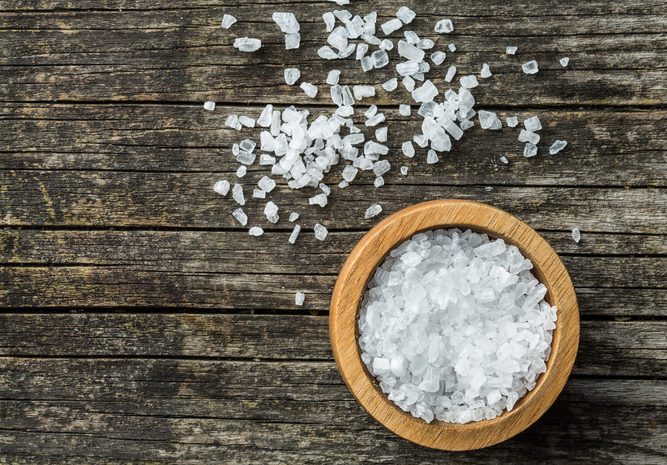
Salt wreaks havoc on your blood pressure
If you’re the type to regularly tuck into a bag of chips, it’s worth reconsidering the habit. Too much sodium isn’t good for anyone, but for people who have hypertension, salt—a sodium compound—is especially dangerous. Sodium leads to small spikes in blood pressure for people who don’t already have hypertension and large spikes in people who do, according to a 2017 review of 185 studies from Europe, Canada, and the United States. Hypertension is the key driver of a number of cardiovascular problems, including heart attacks, strokes, and coronary artery disease. Check out 31 things you should do right now to avoid high blood pressure.

Many restaurant meals contain the amount of salt you should have in an entire day …
A 2013 survey published in the Canadian Journal of Public Health examined 20 sit-down and 65 fast-food restaurants across Canada and found that the average dish contained 1,455 milligrams of sodium. Read up on these 20 tips on how to eat healthy when you’re out at a restaurant.

… and a fancy sit-down meal may be even worse than a fast-food one
The same study found that 40 percent of menu items at sit-down restaurants packed at least 1,500 milligrams of sodium (versus 18 percent of fast-food menu items). The saltiest meal options? Wraps, sandwiches, ribs, and pastas that contained meat or seafood. Learn about the 12 weird effects that fast food has on your brain.

All you need is 1,300 milligrams
Sodium is essential for contracting and relaxing muscles, transmitting nerve signals, and maintaining adequate fluid levels, but we don’t need much of it for these important functions. Health Canada’s recommended sodium intake for people ages 51 to 70 is 1,300 milligrams a day and 1,000 milligrams per day for those over 70. According to the American Heart Association (AHA), Americans eat an average of 3,400 milligrams of sodium a day—way above the AHA’s ideal daily limit of 1,500 milligrams.

Cutting back may be even more important for certain groups of people
The studies in the 2017 review mostly relied on white participants; the authors noted that the few studies with Asian and African American participants suggest that a reduction in salt consumption has an even more significant blood-pressure-lowering effect in these populations. This is believed to be due to genetic differences in how the body processes salt. Learn about 25 scary ways that eating too much sugar affects your body, too.

There’s no way to tell how much salt is in your dish
In 2016, Ontario became the first province in Canada to require chain restaurants to list calories on their menus. Those pushing for the move asked that sodium be labeled, but the Ontario Ministry of Health and Long-Term Care—the government agency responsible for managing the health-care system and services—decided against it. (Critics claimed that the decision was a concession to the restaurant industry.) So far, the only jurisdictions in North America that have passed laws requiring that sodium levels be stated on menus are Philadelphia and New York City, where meals that contain a day’s worth or more of sodium are marked.

“Healthy” options can be just as dangerous
Even seemingly nutritious foods can pack a salty punch. Half a cup of canned tomatoes can have 400 milligrams of salt. A cup of bran cereal can have about 240 milligrams of sodium. And just three ounces (85 grams) of smoked salmon can have more than 660 milligrams. To reduce sodium, try to eat foods in their freshest form possible, and be sure to check the sodium levels noted on the label. Check out the 9 best diet snacks to eat if you’re trying to cut back on salt.

It may lead to weight gain
In 2015, scientists at Queen Mary University of London found evidence suggesting a link between sodium and obesity. By measuring sodium levels in more than 1,200 study participants’ urine and recording their food intake over a four-day period, researchers found that those with high salt levels were more likely to be overweight, even if they weren’t eating more calories than the low-salt group.

Salt increases your risk of kidney stones
It’s not clear why, but sodium likes to grab on to calcium before it’s flushed out of the body through urine. The extra urinary calcium can form into crystals and eventually lead to kidney stones. According to a 2012 study published in the Journal of Urology, women whose diets were high in sodium were between 11 and 61 percent more likely to develop the painful condition. Another small study found that a low-salt diet reduced urinary calcium in both men and women who were prone to kidney stones. Know the 7 clear signs you’re eating too much salt.

Salt can hurt your sleep …
If you find yourself making frequent nighttime bathroom trips, salt could be the culprit. A 2017 European study found that men over 60 who reduced their salt intake by 25 percent decreased the number of times they got up to urinate in the night, from 2.3 to 1.4 times, on average.

… and increase your risk of heart failure
A 2017 Finnish study that followed more than 4,600 people for more than 12 years found that those who had the highest salt levels in their urine at the start were more than twice as likely to suffer heart failure as those who had the lowest levels. The increased risk was found even in salt lovers who didn’t have high blood pressure. Think about avoiding these 13 foods that cardiologists try to never, ever eat.

You likely don’t even know you’re eating it
Often, we don’t taste the sodium because it’s so diffuse in the food. For example, a single croissant has 424 milligrams, while eggs Benedict can pack a whopping 2,015 milligrams of sodium. Why is salt there in the first place? For starters, it’s a preservative. Also, it acts as a fermenting agent in breads and causes food to retain water; for products sold by weight, more liquid means more profit.

Kids are overloading
According to Health Canada, the government department overseeing the country’s public health, 77 percent of children ages one to three and 93 percent of kids ages four to eight are exceeding the recommended daily sodium intake. Learn more about these 13 foods that have way more salt than you realized.

A potassium deficit could worsen sodium’s effects
Like sodium, potassium is an important mineral in the body. While excess sodium increases blood pressure, potassium eases tension in blood-vessel walls and helps keep blood pressure in check. The mineral also aids in sodium excretion so that excess salt doesn’t stick around and cause problems, says cardiologist Suzanne Oparil, MD, a professor of medicine at the University of Alabama at Birmingham. Blood tests ordered by your doctor can confirm whether you’re low in potassium, but so long as you’re eating your fruits and vegetables, you shouldn’t have to worry. High sources of potassium include white beans, spinach, bananas, avocados, sweet potatoes, and yogurt.

You’re falling for fake news
Both the food industry and the salt industry fund research on dietary sodium. “Their interests will often fund the low-quality evidence,” says Norm Campbell, MD, a sodium and hypertension expert at the University of Calgary’s Libin Cardiovascular Institute of Alberta. “And even when they haven’t funded it, they will market the low-quality evidence, increasing its visibility.” Read up on these 21 food myths you need to stop believing.

Salt hides away in processed foods …
According to Health Canada, 77 percent of our sodium intake comes from processed and fast foods. Here are some of the biggest offenders:
- Meat pizza: A heavy takeout pizza has 693 milligrams per slice (that’s more than 2,000 milligrams in three slices!)
- Chicken noodle soup: 1,613 milligrams per can
- Creamy cucumber salad dressing: 131 milligrams per tablespoon
- Processed salami: 1,264 milligrams per 100-gram serving (about 3.5 ounces)
- Store-bought bakery bread: 240 milligrams of sodium per 50-gram serving
Check out these 20 food facts that will change the way you eat.

It might be hiding in your meat
Salt water is injected into some fresh and frozen meat to make it juicy and larger in volume. How can you make sure your choice cut hasn’t been sodium-boosted? Look for packages with no nutrition label—only meat that hasn’t been treated with salt can legally be sold without one in Canada. In the United States, the USDA requires that labels indicate if salt solutions have been added to raw meat.

Reduced intake will save lives
If people were able to reduce their salt intake as recommended, it would substantially reduce the burden of cardiovascular disease and mortality. Learn about more 10 habits you didn’t realize were making you sick.

If you happen to be “salt-sensitive,” sodium is especially harmful
Some people’s bodies are less efficient at flushing out excess salt, and it’s estimated that more than a third of us are affected by the mineral in this way. If you get bloated after salty meals, it’s a sign of salt sensitivity, says Dr. Oparil. If hypertension runs in your family, you’re also more likely to be salt-sensitive.

Sodium is particularly damaging if you are over 50, are overweight, or have diabetes
Studies show that sodium causes blood pressure to increase more later in life. “As we get older, we become more sensitive to salt,” says Dr. Campbell, explaining that the aging body simply isn’t as efficient at flushing out sodium. Blood-pressure spikes after eating sodium-rich meals are also dramatic in people who are overweight and people who have diabetes, though scientists aren’t clear on why. Think about eating these 12 foods that can actually help lower your blood pressure.

Sea salts and rock salts aren’t better than table salt
The fancier products have trace amounts of minerals, like iron and potassium, that are destroyed in the processing of table salt. But according to Dietitians of Canada, the nutritional value of sea and rock salts is so insignificant that switching to more expensive seasonings won’t positively affect your health. All salts contain the same amount of sodium by weight.

It can raise your risk of stomach cancer
The World Cancer Research Fund has estimated that 14 percent of stomach-cancer cases could be avoided in the United Kingdom each year if people kept salt intake to less than 2,400 milligrams per day. Think about cutting out these 17 surprisingly unhealthy foods from your diet.

You’re probably hooked on salt
When our diets are high in sodium, we find low-sodium foods bland. The good news? It only takes about six weeks for our taste buds to adapt to lower-salt foods, Dr. Campbell says. Stick with a lower-sodium diet, and soon you won’t miss the salt.

“Reduced sodium” doesn’t mean healthy
If the original product is way too high in sodium, a 25 percent reduction could still leave you with a product that’s too salty. To be sure a food is actually low in sodium, read the nutrition label. Avoid products that contain 20 percent or more per serving of the U.S. Daily Value of sodium, which is 2,300 milligrams. You can also look for the “low sodium” label. Unlike products that advertise reduced sodium, products that use this wording must have 140 milligrams or less per serving. Next, learn the signs that you’re eating too much salt.